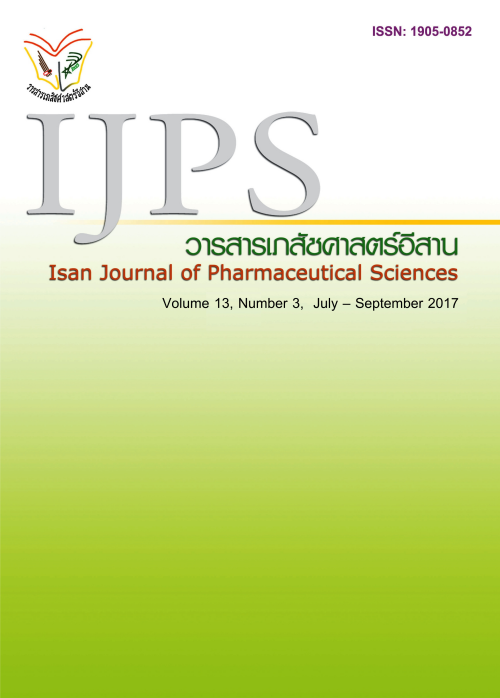Development of a screening tool for predicting the risk of pneumonia in patients with chronic obstructive pulmonary disease
Main Article Content
Abstract
Introduction: Chronic obstructive pulmonary disease (COPD) is a major cause of illness and death. Objective: To develop a screening tool of pneumonia in patients with COPD. Method: This research was Retrospective Cohort Study. The study was conducted in patients with COPD during 1 January 2010 until 31 March 2013. Results: There were 428 patients participated in the study. Patients were 127 pneumonia (29.67%). The risk factors associated with the pneumonia from binary logistic regression analysis age >65 years, Modified Medical Research Council Dyspnoea Score > 3, Hypertension, Previous history of COPD exacerbations and inhaled corticosteroid use > 6 months. Was developed by integrating the risk factors and, the cut-off point for pneumonia prediction is 6 points sensitivity 70.90 percent, specificity 93.70 percent and Area under the Curve of the receiver operating characteristic curve (ROC curve) 85.10 percent. Conclusions: This screening is a tool pneumonia in patients with a COPD. Patients with scores 6 points or over should be forward for pneumonia diagnosis.
Article Details
In the case that some parts are used by others The author must Confirm that obtaining permission to use some of the original authors. And must attach evidence That the permission has been included
References
Calverley PM, Anderson JA, Celli B, et al. Salmeterol and fluticasone propionate and survival in chronic obstructive pulmonary disease. N Engl J Med 2007; 356(8): 775 - 789.
Calverley PM, Stockley RA, Seemungal TA ,Hagan G, Willits LR, Riley JH, Wedzicha JA. Reported pneumonia in patients with COPD: findings from the INSPIRE study. Chest 2011; 139(3): 505-512.
Chatila WM, Thomashow BM, Minai OA, Criner GJ, Make BJ. Comorbidities in chronic obstructive pulmonary disease. Proc Am Thorac Soc 2008; 5(1): 549-555.
Cheng SL, Wang HC, Cheng SJ, Yu CJ. Elevated placenta growth factor predicts pneumonia in patients with chronic obstructive pulmonary disease under inhaled corticosteroids therapy. BMC Pulmonary Medicine 2011; 11: 46.
Crim C, Calverley PM, Anderson JA, et al. Pneumonia risk in COPD patients receiving inhaled corticosteroids alone or in combination : TORCH study results. Eur Respir J 2009; 34(3): 641-647.
Drummond MB, Dasenbrook EC, Pitz MW, Murphy DJ, Fan E. Inhaled corticosteroids in patients with stable chronic obstructive pulmonary disease: a systemic review and meta-analysis. JAMA 2008; 300(20): 2407-2416.
Global Initiative for Chronic Obstructive Lung Disease. Global strategy for the diagnosis, management, and prevention of chronic obstructive pulmoary disease (Revised 2017). Available frome: http://www.goldcopd.org/uploads/users/files/GOLD_Report_2017_Feb21_pdf. accessed on april 16, 2017.
Hosmer DW, Lemeshow S. Applied Logistic Regression. 2nd Ed. New York: A Wiley- Interscience Publication; 2000. 90-142.
Kew KM, Seniukovich A. Inhaled steroids and risk of pneumonia for chronic obstructive pulmonary disease. Cochrane Database of systemic reviews 2014.
Kornum JB, Thomsen RW, Riis A, Lervang HH, Schonheyder HC, Sorensen HT. Diabetes, Glycemic Control, and Risk of Hospitalization With Pneumonia A population-based case- control study, Diabetes Care 2008; 31(8): 1541–1545.
Lopez AD, Mathers CD, Ezzati M, Jamison DT, and Murray CJ .Global and regional burden of disease and risk factors. Lancet 2006; 367: 1747-1757.
Moons KGM, Harrell FE, Steyerberg EW .Should scoring rules be based on odds ratios or regression coefficients. JCE 2002; 55: 1054-1055.
Singh S, Amin AV, Loke YK. Long-term use of inhaled corticosteroids and the risk of pneumonia in chronic obstructive pulmonary disease: a meta-analysis. Arch Intern Med 2009; 169(3): 219-229.
Suissa S, Patenaude V, Lapi F, Ernst P. Inhaled Corticosteroids in COPD and the risk of serious pneumonia. Thorax 2013; 68: 1029-1036.


